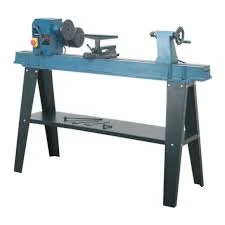Finding Your Perfect Second-Hand Wood Lathe: A Beginner's Guide
Wood lathes are fantastic additions to any woodworking shop, and the used market offers a treasure trove of potential for budget-conscious hobbyists. But with so many options, how do you avoid ending up with a dud? This guide will equip you with the knowledge to find a used lathe that perfectly suits your needs.
Know Your Turning Style:
Before diving in, consider what kind of woodturning you're interested in. Upgrading from an existing lathe means you likely have some preferences in mind. Beginners, however, have a bit more exploration to do. There are two main styles: spindle turning and faceplate turning.
- Spindle Turning: This focuses on creating elongated pieces like table legs and chair spindles. It's a popular starting point for woodworkers venturing into woodturning. After all, making legs for a table can quickly lead to building the entire table itself!
- Faceplate Turning: This encompasses projects like bowls, round tabletops, and vases. Most faceplate enthusiasts tend to gravitate towards bowls.
Modern Lathes Offer More Flexibility:
Most beginner and intermediate lathes can handle both spindle and faceplate turning. Traditionally, older lathes required different setups for each style. Spindle turning was done over the lathe bed, while faceplate work was done "offside" at the headstock end. This meant needing "left-handed" threaded faceplates, which discouraged many woodturners from attempting faceplate turning with larger pieces.
Modern manufacturers often address this with a rotating headstock that allows for larger faceplate projects using standard tooling on the lathe bed.
Speed Matters for Bowl Turning:
One key difference between spindle and faceplate turning is speed. Spindles are generally turned much faster than faceplate pieces. This is important to consider, especially with large, unbalanced bowl blanks. At high speeds, these blanks can cause serious issues:
- Violent shaking: The lathe can vibrate excessively, potentially damaging itself.
- Uncontrolled movement: The lathe may even move across the floor due to the unbalanced weight.
- Projectile hazard: A worst-case scenario is the wood blank coming loose and turning into a dangerous projectile.
Slower speeds are essential for safe and successful faceplate turning. Ideally, look for a lathe with a variable speed control that goes down to at least 600 rpm for bowls around 12 inches in diameter. Even slower speeds are always preferable for safety.
Choosing Your Lathe:
- Spindle Turning: Look for a lathe with a solid bed construction for optimal support.
- Faceplate Turning: Prioritize a sturdy headstock that can handle large pieces and offers variable speed control down to low speeds.
Remember, a wood lathe is a utilitarian tool. Don't get overly concerned about cosmetic imperfections – focus on functionality and features that match your turning goals.
Happy Turning!
Wood lathes open up a world of creative possibilities in your woodworking adventures. With a little knowledge and this guide, the used market can be a great place to find a fantastic, affordable lathe to kickstart your woodturning journey.
Want to Learn More?
Check out the following resources for more in-depth information and inspiration:
- Darrell Feltmate's Website: [Round the Woods website] offers a wealth of information on woodturning for beginners and experienced turners alike, along with a gallery of beautiful turned pieces.
- Free Woodturning Videos: There are numerous free online videos showcasing every aspect of woodturning, from sharpening techniques to crafting bowls. Dive in and explore the world of woodturning!

